Mission San Antonio de Padua (CA Mission #3)
Introduction
Text-to-speech Audio
Images
Ruins of San Antonio de Padua in 1883. By mission's final priest of the 19th century died that year, and only two Native Americans remained living on the site.
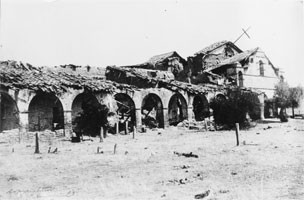
Sketch of how the mission looked in 1843, after years of neglect. Once boasting a population of over 1200, the neophytes had dwindled to a mere 35 families due to mismanagement by the Mexican government.

Mission ruins in the 1870s.
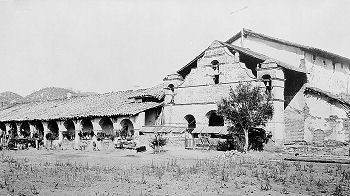
The mission in 1910 following restoration by the California Historic Landmarks League. It took several years to restore just the church--the rest of the buildings would not be rebuilt until 1948-1952.
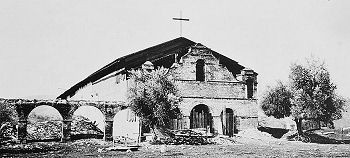
Mission San Antonio de Padua today, known for the exceptional quality of its museum. Cal Poly University leads an archaeological symposium at the mission each year.
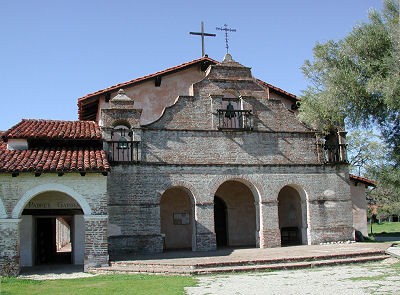
1771 portrait of Juan Bautista de Anza. A soldier and explorer, he created the overland route connecting Spanish territories in Mexico to California. Supplying the missions by sea was impractical--the overland route made settlement possible.
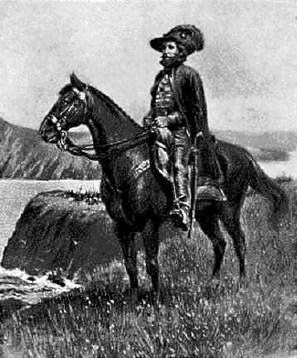
Father Junipero Serra, founder of the California missions. He personally rang the bell that signaled the establishment of San Antonio de Padua. Today he is a controversial figure, viewed as a symbol of genocide by some native tribes.

A National Park Service map of San Antonio's layout. Like most of the missions, it had substantial agricultural lands surrounding it, supplied by aqueducts and reservoirs. Missions were designed to be self-sufficient communities.

The interior of the church itself. Some of the walls were once decorated with paintings by the Indian neophytes.
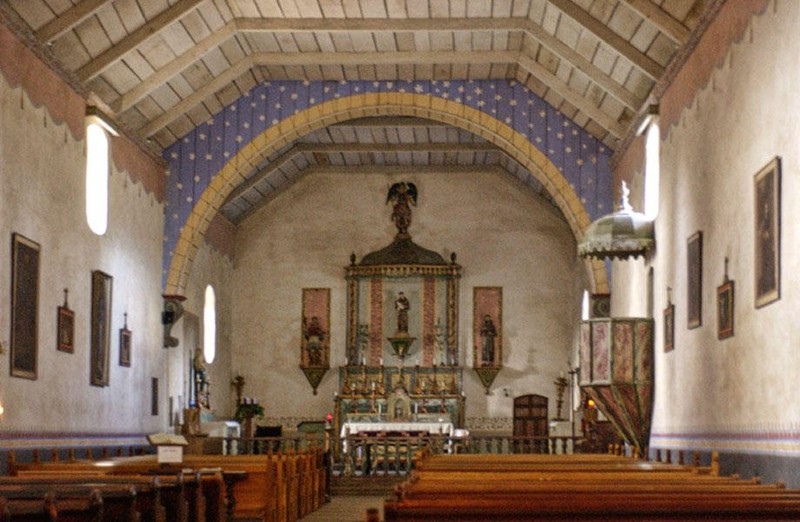
The figureheads from two colonial ships remain at the museum, supposedly gifted by thankful sailors to the mission's padres.
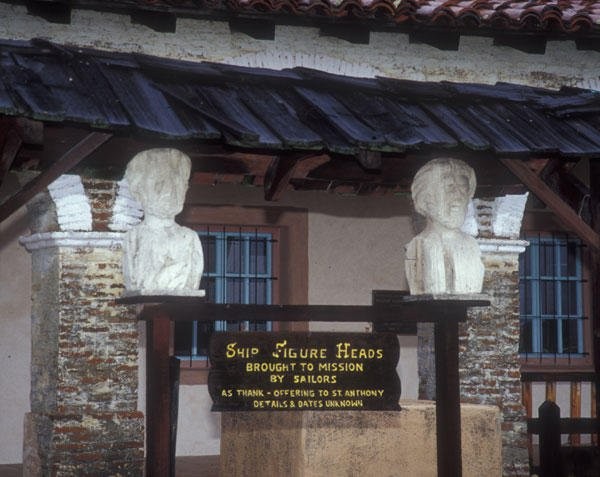
Backstory and Context
Text-to-speech Audio
Established by Father Junipero Serra on July 14, 1771, this was the third mission in the northern frontier of Spain’s New World conquest of Alta California (Upper California). After a short Mass and dedication meeting, Serra was eager to continue north to establish more missions. In his zeal, he hung what would be the mission bell on an oak tree rather than have a cross built and erected. He left the mission under the leadership of Fathers Buenaventura Sitjar and Miguel Pieras, who began to build the mission and Christianize the local Salina indian tribe.
By the next year, well before its construction was complete, the mission’s constituents were already suffering from starvation. A hunting party was sent south to what is today the city of San Luis Obispo, to “the Valley of the Bears,” where the original Spanish explorers had noted an unusually large population of the carnivores. The hunting party, which was also rounding up supplies for the similarly started Mission San Carlos Borromeo in carmel, returned with approximately 9,000 pounds of salted and jerked bear meat, in addition to seeds from the friendly Indians encountered in the valley.
The original site of San Antonio de Padua was located closer to the San Antonio river, but in 1773 it was moved to its current location due to periodic flooding--the same year it hosted the first Catholic wedding in California, between an Indian woman and a Spanish soldier. The new site was further north in the Los Robles Valley. A dam built on the San Antonio River, three miles of aqueducts, and a reservoir system conveyed a reliable supply of water to the new location. Much of the waterworks infrastructure still exists.
Workshops, a small church, and houses were constructed to barrack approximately 163 soldiers and Indian converts who formed the mission’s population (by this time, 158 persons had been baptized). A gristmill, still seen today, was added later. The following year, Spanish adventurer and explorer Juan Bautista de Anza, famous for the overland route he had blazed connecting Sonora in New Spain (Mexico) to the San Francisco Bay, came through the area in his expedition. This route, El Camino Real, or, The King's Highway, would eventually connect all 21 missions in California from north to south.
In 1775 (the same year the first shots were fired in the American Revolution), local Indians attacked the mission--the only Indian attack on a Spanish mission in central California. The local garrison repulsed the attack. By 1779, the mission had created positions of authority to be held by the Christianized Indian neophytes, signaling the quick growth of the community. Indeed at this time, the mission held the largest population of the central California region with 1,076 indians--the first mission to have a population of over a thousand. Weaving and wine-making were its strongest industries, though the mission also had large herds of livestock and grew crops of wheat, barley, beans and corn, as it was part of the Franciscans’ modus operandi to make every mission self-sufficient.
Still the mission grew. In 1795 and 1791, elections were held in the mission, and neophytes were elected to positions typically given to Spaniards. In 1801 a cemetery for Indians was added to the grounds, and in 1805 the mission reached its peak with 1,296 residents. Despite this rapid growth and the formation of many ranchos, a pueblo (town) was never established like at other missions. Instead, by 1809 an adobe village flourished near the mission walls, along with smaller communities on the ranchos that rose up as more Spaniards arrived in the area.
In 1821, Mexico won its independence from Spain, and soon the mission began to decline. The large influx of settlers to the area brought disease to the native population, and the new Mexican government levied heavy taxes upon the missions and their communities. Soon, Mexico's Secularization Laws of 1833 were passed. Missions up and down California’s coast were divided up and sold, or placed under the control of government administrators who often exploited the communities in their charge. Unlike other missions, however, the now-secularized San Antonio de Padua was never sold.
This did little to slow its decay. By 1843, the mission was in such a poor state that its massive lands and properties could not even be sold for the rock-bottom asking price of just over $8,000. The arrival of American troops prevented corrupt California governor Pio Pico from attempting to sell the mission again, but San Antonio de Padua continued to languish. Finally in 1863, under a directive from President Lincoln, the mission and its land was given back to the Catholic Church. By then, its ostentatious acreage held only 35 families and a priest from Mexico.
In 1882, when the priest from Mexico died, only 2 indians remained at the mission. That same year, the mission was finally abandoned. It was looted in 1883: the roof tiles were taken and used for a Southern Pacific railroad station in Burlingame. Exposed to the elements, the adobe structures hastened into further disrepair.
From 1903 to 1908, a group formed with the objective of restoring the deteriorating missions: the California Historic Landmarks League. The Honorable Joseph R. Knowland led the group, touring the state and petitioning for funds. Seeing as it was “the largest and most picturesque of the remaining missions of Northern California” the League selected Mission San Antonio to begin their work. Fundraisers were held at the Mission every St. Anthony’s Day (June 13) to spark interest. The Indian family Encinales assisted in the work.
They underestimated the task and the power of nature, however, and restoration took significantly longer than planned. A winter of heavy rain washed away the work of the prior summer and the 1906 earthquake, which damaged many of the other missions, toppled repairs at San Antonio de Padua. Deliveries could not be made due to muddy roads. Still the efforts continued, and the church was restored by 1907. The League left San Antonio in 1908. Mission San Antonio was returned to Franciscan control by John B. MacGinley, Bishop of Monterey-Fresno, in 1928.
In 1948, a second round of reconstruction began. As San Antonio de Padua stood on grounds owned by William Randolph Hearst and was used as a hunting game reserve, Hearst had borne the duty of protecting the Mission. At this time the Hearst Foundation financed a new restoration. Dilapidated buildings (except the restored church) were torn to the ground and rebuilt with old materials and methods (except for modern strengthening inside the walls). In an attempt to reconstruct the mission as close to its 1813 design as possible, work was supervised by Harry Downie, known for his restoration work at San Carlos Borromeo de Carmel and other missions. The Franciscans also contributed, hoping to make the mission a training school for brothers of the order. Work continued into the 1950s, when as part of the hunting game reserve, Hearst architect Julia Morgan also built a lodge called “The Hacienda” near the Mission. The Hearst Foundation eventually traded the land and Mission to the U.S. Government in for its use as a military reservation. The Department of Defense provided a team of archaeologists to help preserve all historical artifacts in the valley.
June 4, 1950, a re-dedication ceremony took place at the Mission. The bell rung at this ceremony was recast from two American-made bells. These had been hanging at the San Gabriel Mission and were made by Paul Revere in Boston. At the time, they were the only two American-made bells in the mission system. On July 14, 1971, a Bicentennial celebration of the mission’s founding was held at the mission.
Although surrounded by Fort Hunter Liggett, the mission is still open to the public. In the cemetery are buried five of the padres who ministered at Mission San Antonio de Padua. With its somewhat remote location, the countryside surrounding the mission is considered to be the closest in appearance to when the Spanish mission was in operation.
Sources
Leffingwell, Randy (2005). California Missions and Presidios: The History & Beauty of the Spanish Missions. Voyageur Press, Inc., Stillwater, MN.
Ruscin, Terry (1999). Mission Memoirs. Sunbelt Publications, San Diego, CA.
Yenne, Bill (2004). The Missions of California. Advantage Publishers Group, San Diego, CA. "California Missions." Lowman Publishing Company, Arroyo Canyon, CA. 2011. pp16.
